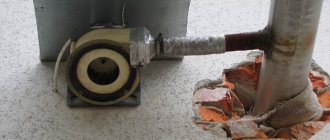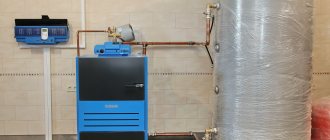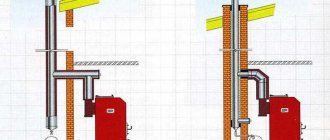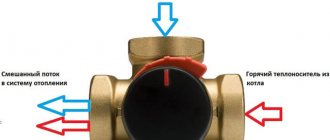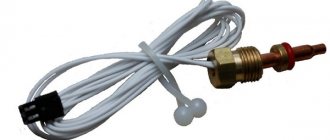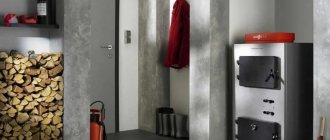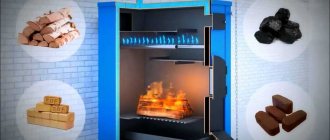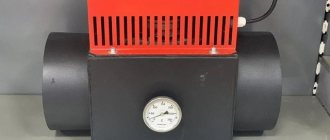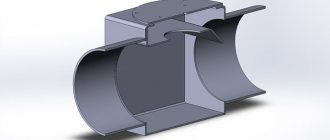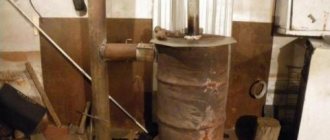Previously, draft and blower fans were used only in industrial boiler installations. The first ones are placed inside the chimney channel and create a vacuum, the second ones pump air into the firebox. Gradually, the units migrated to the domestic sphere - manufacturers began to equip heaters with a closed combustion chamber with turbines. The idea was picked up by home craftsmen, because a smoke exhauster for a boiler helps solve the problem of poor draft in the chimney pipe. Let's figure out whether forced exhaust of combustion products is always necessary.
Design and principle of operation
An exhaust fan for a factory-made boiler includes the following elements (the device is shown in the diagram, the positions coincide with the points):
- Metal heat-resistant impeller with blades bent at 90° relative to the impeller.
- Mounting plate.
- Low-performance electric motor (20…50 W).
- Power cable connector.
- Remote control with controls and controls.
- The flask and capillary tube of a temperature sensor connected to an emergency thermostat.
- Power cord with plug.
Note. The boiler smoke exhauster DM-01 from Kalvis is taken as an example. The design of other types of fans differs in the shape of the housing - volute, box, hemispherical landing pad. The set of parts is similar.
The unit is attached to a special box located on the rear panel of a domestic TT boiler next to the chimney pipe. The temperature sensor bulb is inserted into the immersion sleeve of the water jacket, the remote control is placed separately.
The principle of operation of the smoke exhauster is the forced removal of high-temperature gases from the fire-tube heat exchanger of the boiler into the chimney. The algorithm looks like this:
- The firebox is filled with wood and ignited.
- The loading door is locked, the blower door is opened. The fan is turned on using a key on the remote control, then the performance is adjusted.
- When the heating installation and chimney have warmed up, the impeller speed is manually reduced to a minimum. If the heat generator has enough natural draft, it is recommended to turn off the smoke exhauster.
- When the coolant heats up to a critical temperature of 100 °C or more, at the command of the sensor, an emergency thermostat is triggered, turning off the fan automatically.
Diagram of operation of a boiler smoke exhauster
Reference. On TT boilers equipped with an automatic draft regulator, there is no need to open the ash pan door. The thermostat, through a chain, will open the air supply damper to the required angle.
High or low performance of the draft fan is set individually depending on the quality of solid fuel, combustion mode and degree of heating of the chimney. The main thing is to avoid the accumulation and leakage of smoke into the room.
You also can’t go overboard with the speed - the lion’s share of the heat will go down the drain. Before opening the door and reloading, it is better to increase the rotation speed to maximum.
A ready-made fan unit from the famous Russian brand Zota is mounted on wood-burning heaters with rear gas outlet
Pressurizing the boiler with your own hands
The popularity of solid fuel boilers is explained by their independence from electricity, ease of operation, efficiency and availability of fuel. In cases where there are no funds to purchase a factory model, you can build such a heater yourself.
Classification
Before you make a long-burning boiler with your own hands, you need to familiarize yourself with the necessary information
Today there are three main types of solid fuel boilers:
Although devices can be classified according to other criteria, most often when choosing the appropriate option they look at the type of fuel used.
Pyrolysis
Such boilers are distinguished by very slow combustion of fuel in oxygen starvation mode. This allows you to increase the volume of combustible gases produced: their repeated combustion increases the efficiency of the device to 85-90%. There is an opinion that it is impossible to make such a unit yourself. Indeed, this is not easy to do, but it is possible.
Classic
We are talking about a standard wood stove. If you reduce its combustion chamber, you can slightly reduce the rate of combustion of wood. Due to their simplicity, such designs are most often chosen for self-production. In the future, it is possible to additionally equip a classic boiler with a water heating circuit to meet the needs of domestic hot water.
Pellet
The most efficient equipment, the efficiency of which often reaches 95%. Unlike other models of solid fuel boilers, in this case automatic mode is possible.
To do this, a special auger belt is installed from the bunker with pellets to the combustion chamber, through which the fuel evenly flows into the unit.
Due to the complex device and the presence of an automatic unit, it is almost impossible to produce such a design on your own.
What fuel is used
The modern market offers the following types of solid fuel:
- Firewood, or its European variety, made from pine or deciduous sawdust.
- Biopellets in granules. We are talking about pressed sawdust, peat, waste from the woodworking industry and agriculture.
- Hard coal and anthracite.
- Waste from wood processing or agricultural industries.
To increase the profitability of heating, the priority is factory-made or home-made boilers of a universal type, capable of consuming all of the above types of fuel. In this regard, combined equipment has proven itself very well, for the operation of which alternative fuel is suitable. The switching procedure is very simple and does not take much time.
Combination boilers are:
- Electric.
- Solid fuel.
- Universal.
Design features and operating principle
The operation of a solid fuel boiler is based on an extremely simple principle: air sucked in from below circulates through the walls of the chamber. Once inside the room, hot air begins to heat the surrounding space. Long-burning units are supplied with air in very measured doses.
To reduce the combustion rate and reduce the free space inside the firebox, when laying fuel they try to achieve maximum density. For work, you need to prepare the following materials and tools: a 30-50 mm pipe, a 0.8 mm steel sheet, a metal corner, fittings, a pipe with a cross-section of 250 mm (an old gas cylinder will do), a grinder and a welding machine.
How to make a boiler with your own hands - manufacturing technology
Before you make a solid fuel boiler with your own hands, you need to understand all the details of the design. The procedure for constructing a long-burning solid fuel boiler with your own hands:
- Manufacturing of air supply controller. For this purpose, the pipe is equipped with a welding bolt. After this, using a grinder, you need to cut a circle from a steel sheet, the diameter of which corresponds to the pipe. Its edges are equipped with holes in such a way as to achieve free immersion of the bolt for fastening the cover with a regular nut. Using this circle, it will subsequently be possible to dose the volume of incoming air, controlling the intensity of the flame.
- The same pipe is decorated with a series of small horizontal gaps. They will act as air vents.
- Another circle is made from a steel sheet: its diameter should be 5-10 mm smaller than the cross-section of the firebox. A hole is made in the center of the circle for a tube with a plug, with further welding 20-30 cm from the edge.
- The body is made. If an old gas cylinder is used for this purpose, it must first be freed from the upper part (where the tap is). When using a 250 mm pipe, it is first plugged at the bottom.
- To build a chimney, a cutout with a diameter of 100 mm is made on top of the cylinder (10 cm from the edge), and a pipe with thick walls is welded into it.
- To install the vent for the boiler, the bottom of the furnace is equipped with a hole for the pipe: it must be inserted in such a way as to ensure that the vent for the solid fuel boiler exits outside the body. Be sure to place it below the level of the chimney: this will ensure good air circulation.
- The heat dissipation screen is constructed from a sheet 10 mm thick. A circle with a diameter of 200-220 mm is cut out of it. For ease of use, a reinforcement handle is welded onto the screen.
- The convection casing has a cylindrical shape. It is made of sheet metal: the diameter of the structure should be 50-70 mm greater than the firebox. To assemble the structure completely, the base of the boiler and the convection chamber are welded together.
- To make the top cover of the device, you can use a previously cut part of the cylinder. If sheet metal was used, then a circle of the same diameter is made from it, with welded handles made of reinforcement.
Types of traction fans
Several types of smoke exhausters are sold for solid fuel boilers and wood-burning fireplaces:
- boiler (the design is discussed above);
- centrifugal channel;
- overhead;
- fireplace/stove (aka roof).
Various attachments that improve natural draft, such as deflectors, round rotating elements and rotating weather vanes, should not be classified as smoke exhausters. The effectiveness of these hoods depends on the wind speed, which changes with the weather.
Varieties of duct smoke exhausters, some models are equipped with temperature sensors.
The duct fan is distinguished by its own housing with two connecting flanges or pipes. The unit is installed vertically or horizontally into the gap in the chimney duct. The device and principle of operation are similar to the operation of a boiler smoke exhauster.
The overhead smoke exhauster for a domestic boiler is equipped with a semicircular platform and clamps-ties. Installation is carried out on a vertical section of the chimney (uninsulated):
- An opening is cut out in the pipe using a paper template.
- The impeller of the traction machine is inserted into the hole, and the platform with the electric motor is pressed to the surface with clamps.
- The connection is sealed with an asbestos cord glued to the inside of the installation site of the smoke exhauster.
Note. The overhead element is selected according to the diameter of the flue pipe. The installation process is demonstrated in the video.
Electric fireplace hoods are mounted on the head of a brick chimney and secured with spacer bolts. The power cable is laid through a pipe and introduced into the room next to the home stove.
To choose a traction machine, you need to focus on 3 criteria:
- heat generator power, smoke exhauster models are designed for boiler performance up to 20, 30, 50 and 100 kW;
- installation point - on the boiler itself, pipe or head;
- for overhead models – the diameter of the uninsulated flue.
Overhead (left) and roof-mounted smoke exhauster (right)
Main characteristics
The efficiency of draft equipment is assessed by three main characteristics - productivity, power and pressure level. In terms of performance, the blower fan can have up to 10 m3/h. That is, this is the volume of air mass released within one hour. True, most standard models provide only 3-4 m3/h. This value is directly related to the power of the installation, which on average varies from 5 to 10 kW. But the quality of the function will also depend on the engine speed - on average 1000 rpm.
As for pressure, the indicators here are also quite tight - at least in the middle segment. For example, a small boiler fan can provide 50-60 daPa. Another thing is that high-performance industrial systems can operate in modes of 200-300 daPa.
(no votes yet)
When do you need a smoke exhauster?
Manufacturers of heating equipment equip their products with traction fans due to the increased resistance of the heat exchanger, where gases change direction of movement several times through the flame tubes. The goal is to remove maximum heat from combustion products and increase the efficiency of the boiler installation.
A nuance: the operation of the smoke exhauster in a factory-installed boiler is coordinated with the combustion process and is controlled by an electronic unit. When installing a fan unit on a “brainless” heater, such consistency is excluded; you need to buy an automation unit or adjust the speed manually.
Organize fresh ventilation in the boiler room, and only then think about installing a smoke exhauster
We list the situations when a smoke exhauster will help improve the operation and maintenance of a solid fuel heat generator:
- problems with draft - blowing by the wind, air pockets in the gas duct, many turns, narrowing of the diameter;
- due to the design features, the boiler smokes into the room when the door is opened;
- the height of the chimney is insufficient or the cut of the pipe fell into the wind support zone behind the ridge of the roof or another building;
- Cracks have appeared in the brick pipe, from which smoke is leaking.
Important point. No fan will save the situation if there is no influx from the street in the boiler room. At first, the working impeller will create a slight vacuum, but then the blades will begin to mix the air in place. Supply ventilation is a prerequisite for the normal operation of any heater.
It is better to operate the V. G. Kholmov mine heat generator with a traction fan.
Some designs of wood-burning boilers (for example, shaft type) tend to emit smoke through an open loading hatch. A similar picture is observed in heat generators with a three-pass fire-tube heat exchanger of high resistance. The solution to the problem is to install a traction or blowing machine controlled by a controller.
Strengthening natural draft with the help of a smoke exhauster also has a downside. If, after warming up the pipe, natural exhaust has not been restored, the unit cannot be turned off - you may get burned. Now imagine that in the middle of the night the power supply goes out and the fan stops. While the chain thermostat closes the damper, smoke will fill the boiler room.
Recommendation. The smoke exhauster should not become a panacea. Be sure to take measures to restore draft - repair or alter the flue in accordance with the requirements specified in the boiler instructions.
Which is better - a smoke exhauster or a blower?
When the traction turbine is integrated into the heat generator by the manufacturer, such questions do not arise. Adding an exhaust fan to a conventional direct combustion boiler is another matter. You need to understand that in this case, the smoke exhauster solves only 1 problem - creating a vacuum in the firebox and increasing draft. There are a number of negative points here:
- Without an electronic control unit, performance will have to be adjusted manually. Automatic maintenance of coolant temperature is excluded.
- When air is supplied through the open ash chamber door, the fan will force the boiler to operate at maximum. Setting up a long burn mode will not be easy.
- In the event of an emergency stop of the impeller, fuel combustion will not stop, since gases pass freely through the volute or the body of the smoke exhauster. Air enters the firebox, increasing the likelihood of overheating.
- The impeller and internal surfaces of the unit become covered with soot, which must be removed. The rate of sticking depends on the moisture content and resin content of the wood.
Comment. We don't mention the fan's power consumption. The consumption is relatively small and will not have a significant impact on the overall cost of heating.
A blower fan with an automation unit performs the same functions as a smoke exhauster.
The disadvantages described in paragraphs 1 and 2 are eliminated by connecting the smoke exhauster with a controller that controls the speed of the impeller and the temperature of the water jacket. Electronic units can be purchased at a price of 50-100 USD. e.
Blowing machines always work in conjunction with a controller, so the problems listed above do not exist:
- the blower changes performance and turns off at the command of the control unit, the coolant heats up to the set temperature;
- during the combustion process, the ash pan door is hermetically closed, air is supplied through a separate channel;
- when there is a power outage, the air channel is automatically closed by a gravity damper;
- the impeller blades do not come into contact with hot smoke and soot.
Reference. In pyrolysis boilers, pressurization is always used, since the operation of this type of heater is based on forced air injection.
Now let’s compare the cost of a traction fan and a blower fan, not taking into account the price of the controller. A smoke exhauster for a TT boiler up to 30 kW will cost 90 USD. e., supercharger - 60-65 cu. e. The difference is due to the design features of the exhaust unit - hot gases should not overheat the electric motor, plus the impeller is made of metal (when pressurized, it is made of plastic).
Behind the mounting flange of the unit there is a small impeller designed to cool the electric motor
The installation complexity of the units is approximately the same. Installation of the discharge volute involves cutting out an opening in the ash pan door, and the smoke exhauster involves disassembling or cutting out the pipe. It is easier to install a roof hood, but you will have to pull a long cable.
Brief conclusion: install a smoke exhauster only if necessary, or better yet, correct mistakes made during the construction of the flue. Add electronically controlled turbocharging as desired - the system will automate and secure the combustion process.
Fan for a solid fuel boiler: types, selection, manufacturing
Installation of a blower fan on a solid fuel boiler is carried out to optimize combustion processes, which leads to an increase in the efficiency of the thermal circuit and fuel economy.
A fan for a solid fuel boiler can be made independently, which will allow the owner to save significant funds on purchasing a factory-made analogue.
Purpose of a boiler fan
A modern heat supply system involves the installation of an automation unit to regulate the thermal processes of the boiler. It is based on changing the supply of air, which is supplied to the combustion zone by a blower fan and is considered more progressive compared to gravity systems.
The completeness of fuel combustion and the operational productivity of a solid fuel unit largely depend on the volume of supplied air and the size of the draft in the combustion chamber.
The automation unit is equipped with a controller that, according to an established algorithm, regulates the operation of the blower, supplying different volumes of air, thereby supporting the combustion process and, accordingly, the production of a certain amount of thermal energy.
The use of a fan in the boiler control system allows:
- maintain the required temperature of the heating fluid in the heating system;
- increases the time the unit reaches operating mode;
- optimizes solid fuel combustion processes;
- increases the efficiency of a solid fuel installation;
- facilitates the process of servicing the heat supply system;
- reduces specific fuel consumption for the production of 1 Gcal of thermal energy.
Varieties
Today, in the retail chain, it is possible to purchase various models of blower fans for solid fuel heating units, both domestic and European assembled.
The most popular options for the location of blowing units are:
- The invoice is installed on a vertical section of an uninsulated smoke ventilation duct.
- Centrifugal duct, have two mounting pipes installed in the chimney gap.
- Boiler installed directly on the heating device.
The following classification of blowing units is made according to the type of electric motors: asynchronous, electrically commutated EC and synchronous.
Electrically commutated motor
The Electronically Commutated Motor (EC) allows very precise performance adjustments using a pulse width modulation signal.
Electrically commutated drive
In the case when they are installed on blowing devices, it becomes possible, by changing the speed of rotation of the impeller - impeller, to change the volume of air supplied to the furnace, thereby reducing energy consumption from 50 to 80%.
Despite the high cost of such blowing devices, they are preferable in the installations of modern boiler units, since they are energy-efficient devices, and their use reduces emissions into the environment by reducing thermal energy losses due to underburning of fuel.
EC motors operate in a quiet range and have an extended service life.
Synchronous motor
The blower fan for a boiler with a synchronous motor is characterized by a simple design and a low price. The disadvantages of this model include a limited adjustment range and low torque when starting the engine. As a rule, such blowing devices are installed to supply a constant volume of air into the combustion chamber.
Boilers with fairly large dimensions are equipped with such engines. Basically, such engines are mounted in a separate block.
When operating synchronous motors at low speeds, winding overheating often occurs. In an exhaust type boiler, fans are installed on the chimney; they are also called smoke exhausters.
Blowers with asynchronous motor
Such electric motors have many advantages. They are convenient and easy to maintain and are durable in design. A disadvantage of this type of electric drive is high starting currents.
Therefore, it will be necessary to properly arrange the power part in order to put into operation such a device that is sensitive to current parameters.
The asynchronous electric motor makes it possible to easily adjust the speed. Certain modifications also have a reverse mode. The main positive qualities of fans with an asynchronous electric motor:
- simple and easy to use;
- have a durable design;
- traditional control scheme;
- used by a variety of control systems paired with a thermostat, for example, like the budget fan DP-02 from a Polish manufacturer.
Features of choice
The performance of a boiler unit operating on solid fuel is largely determined by a professionally selected supercharger.
In order to choose the right fan, you need to pay attention to the following parameters:
- Comparable with heating boiler.
- Blowing device performance and operating voltage.
- Type and principle of operation.
- Metal housing and working impeller.
If the equipment is chosen incorrectly, when the fan for a solid fuel boiler is unable to supply the required volume of air to the furnace, the process of incomplete combustion of the fuel will begin, the efficiency of the boiler will drop, and the temperature regime will not be achieved.
If the blower is installed with high power, it will release a large amount of air into the firebox.
The combustion process will be intense, the boiler will quickly reach the required temperature and the control unit controller will give a signal to turn off the fan, thus the blowing device will enter the clocking process, when it will often turn on and off, which will lead to premature wear of the equipment and its failure.
Recommended installation options for WPA fans for ZOT or Carbon boilers, for heating units operating on anthracite:
- WPA 120, incoming air volume – 285 m3, power – 32, kW.
- WPA 140, incoming air volume – 395 m3, power – 44, kW.
- WPA 142, incoming air volume – 505 m3, power – 56, kW.
- WPA 160, incoming air volume – 600 m3, power – 67, kW.
Do it yourself
Modern solid fuel boilers are widely equipped with blower fans, which allows automation of the combustion process.
You can make such a device with your own hands at home. You only need to balance the impeller, the blades of which must have equal weight and configuration.
To produce a homemade fan you will need:
- Guide steel or aluminum box in the shape of a snail.
- Electric motor 150 W and shaft and 1400 rpm.
- Fastening material, large studs with nuts for fastening to the boiler body.
- Shaft with cooling ventilation grille for impeller.
- Electrical cable for powering the fan.
- Control unit with controller.
It is much easier to make a blower fan for a boiler by selecting an electric motor with an impeller and an impeller.
In this option, you will need to make an iron box, place the engine and impeller in the center and connect the fan to the solid fuel boiler.
You can make the impeller yourself using the appropriate drawings.
The blades are made from a sheet of metal, then they are lightly tacked by electric welding, they are balanced on the shaft and the quality of rotation is checked.
A professionally made fan should be completely free of blade pulsation.
The automation unit for controlling such a fan consists of the simplest versions of a temperature sensor and a dimmer that reduces or increases the engine speed based on the hot water temperature.
In addition, it is possible to purchase automatic units in the retail network that have advanced logic and are well integrated into the automatic boiler control mode.
You only need to professionally select a fan, whose power must match the characteristics of the heating boiler.
It is possible to make a fan with your own hands in order to ensure complete combustion of fuel and adjustment of the boiler depending on the required temperature conditions.
How to make an exhaust unit
The main difficulty in assembling a smoke exhauster with your own hands is making a balanced impeller; the remaining parts are not difficult for a home craftsman who knows how to weld. If the impeller blades vary in weight, normal fan noise will turn into rumble due to vibration.
In addition to the blades, you will need the following elements:
- electric motor with a power of up to 150 W, maximum shaft speed – 1400 rpm;
- snail or homemade box shown in the drawing;
- a shaft with ventilation holes or an additional cooling impeller;
- studs with M8 nuts and other fasteners;
- power cable.
We offer ordinary homeowners the least thorny path - buy a factory electric motor with an impeller and a cooling impeller, weld the box and assemble a fully functional duct smoke exhauster for a TT boiler. How to do this correctly, watch the video.
Structural differences
The structural parts of WPA superchargers are made of silumin, which makes them lightweight and easy to install. There is virtually no background noise during the operation of the blower fan. The blades of the device are protected from the penetration of various objects using a safety grille. WPA series blower fans can operate over a wide temperature range, including +40C.
Supercharger operation
The operation of air blowers for solid fuel boilers is carried out according to the following principle. When the fuel combustion temperature drops below the value set on the automatic control unit, the fan automatically turns on. By supplying air to the firebox, the WPA fan helps to increase the combustion temperature and bring the boiler to a suitable operating mode. Thanks to the installation of blowers, you don’t have to worry about the lack of draft in the chimney or changes in atmospheric conditions - an artificial ventilation system will allow the fuel to burn perfectly under any conditions.
Listed below are the key technical features of nine models of commonly used boiler blower fans.
Fan Metrix DM30SkTc up to 50kW
The blower is designed for boilers with a power of up to 50 kW
